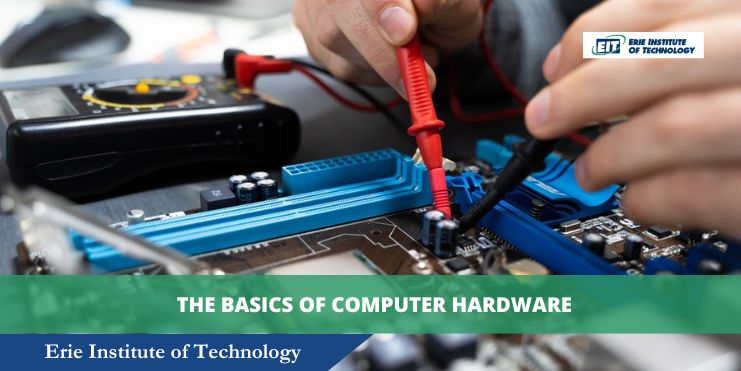
Whether you’re a tech enthusiast or an aspiring IT professional, it’s important to know your way around the parts of a computer. In the broadest sense, computer systems comprise two components: software and hardware. While they cannot operate independently, computer hardware and software interact with each other to bring the technology we use every day to life.
Software refers to the programs and applications we utilize to transmit or store data, watch videos, or listen to music. A relevant example of computer software is the word processor used to write this article.
On the other hand, hardware is every physical part of a computer. It provides the resources that software needs to operate. An equally relevant example of computer hardware is the mouse you used to click on the link that brought you to this article.
Let’s review the different types of computer hardware together. By the time you’re done reading, you’ll have a basic understanding of:
- How each part of your computer’s hardware functions
- How to troubleshoot basic computer hardware issues
- How to upgrade and maintain your hardware for better performance
- Why learning about computer hardware can lead to a rewarding career in any industry
Major Categories of Computer Hardware
Computer hardware can be broken down into three categories: internal hardware, external hardware, and networking hardware. We’ll begin by listing and describing the components within each of these categories.
Internal Hardware Components and Their Functions
1. Motherboard
This is the main circuit board that enables communication between all computer components through a network of integrated circuits and connectors.
2. CPU (Central Processing Unit)
As the computer’s brain, the CPU executes program instructions and processes data. CPU performance is usually determined by clock speed and the number of processing cores.
3. RAM (Random Access Memory)
RAM is temporary, high-speed memory that stores active programs and data for quick access by the CPU. It is cleared when the power is turned off — which is why it’s always a good idea to save your work before shutting off your computer.
4. Storage Devices
- HDD (Hard Disk Drive): Using magnetic platters to permanently store data, this traditional storage system offers high capacity at lower costs.
- SSD (Solid-State Drive): With no moving parts, this flash memory-based storage system provides faster data access and improved reliability.
- NVMe Drives: This high-performance storage system connects directly to the motherboard for significantly faster data transfer speeds.
5. Power Supply Unit
Converts AC power from wall outlets into stable DC power for computer components to use safely.
6. Cooling Systems
Consisting of fans and heatsinks, cooling systems are designed to prevent hardware damage by removing the heat generated during operation.
External Hardware Components and Their Uses
1. Monitor
Monitors are the screens that display computer output. They’re usually made with LCD or LED technology and come in various resolutions and refresh rates for preferred image quality.
2. Keyboard
This is the input device for typing text and commands. Keyboards are available in mechanical or membrane variants with different key mechanisms.
3. Mouse
Utilizing either optical sensors or mechanical balls to track movement, the mouse is the “pointing device” we use to navigate the computer interface.
4. Printers/Scanners
Printers are the output devices we use to create physical copies of digital documents. Scanners, on the other hand, digitize physical documents into computer files.
Essential Networking Hardware
1. Network Interface Card (NIC)
This computer hardware component allows the computer to connect to networks through wired or wireless means.
2. Router
This is the external machine that directs data traffic between different networks and connects devices to the Internet.
3. Switch
The switch connects multiple devices within a local network, managing their traffic and communication.
4. Cables
Ethernet and fiber optic cables are the physical wires that connect networking devices and computers for data transmission.
Peripheral Devices
In addition to its main hardware, your computer has inputs to which you can connect peripheral devices for enhanced utility and efficiency. Some examples of peripheral devices include:
- Audio & Video Peripherals: Speakers, microphones, webcams
- Input Devices: Stylus, trackballs, VR controllers
- Storage Peripherals: External HDDs, USB flash drives, secure digital (SD) cards
Hardware Maintenance and Troubleshooting
Common computer hardware issues often have straightforward solutions when properly diagnosed.
Computer Hardware Issues & Fixes
- For CPU overheating, check cooling fans for dust buildup and ensure proper ventilation.
- RAM failures typically manifest as system crashes or boot failures. Test with diagnostic tools or remove and reinsert the memory modules to resolve these types of issues.
- Hard drive crashes require immediate attention. Stop using the drive to prevent further data loss and consider professional recovery services for critical data.
- Power supply problems can be diagnosed by checking connections, testing outlets by plugging in other devices (such as a lamp), and listening for unusual sounds.
Computer Hardware Preventative Maintenance
- Regularly clean internal components with compressed air and external surfaces with anti-static cloths. Avoid using strong cleaning solutions except for diluted ammonia on external cases.
- Ensure proper airflow by keeping ventilation paths clear and avoiding enclosed spaces that restrict air circulation. Monitor system temperatures and performance to catch potential issues early.
Hardware Upgrades for Better Performance
Strategic computer hardware upgrades can significantly improve system performance without requiring a complete replacement.
- Adding RAM improves multitasking capabilities and overall system responsiveness, particularly when running memory-intensive applications.
- Upgrading from an HDD to an SSD provides dramatic improvements in boot times and file access speeds.
- For gaming or content creation, consider a dedicated graphics card to offload visual processing from the CPU. You will need to make sure your power supply can handle new graphics processing unit (GPU) requirements.
- Add peripheral devices such as additional monitors or ergonomic keyboards to boost comfort and productivity.
Mastering Computer Hardware for the Future
Computers are essential for navigating daily life and doing business in a digital world. Staying informed about technological advancements in computing is important for those looking to optimize their offices. It’s especially important for those who want to think bigger.
Erie Institute of Technology provides marketable skills aspiring computer technicians or IT professionals can use to jumpstart their careers. Industries everywhere rely on people like those we train in our IT Specialist and Computer & Design Programs to design, install, and repair critical computer components and network infrastructures.
Become an indispensable resource for your future employer. At EIT, we prepare students and professionals for in-demand computer careers by providing hands-on training in flexible, accredited educational programs.
Request more information or register today, and get ready to join a workforce of IT professionals and computer technicians who directly impact companies’ bottom lines by optimizing their digital infrastructures.

Ross Aresco
CFO
Ross Aresco is the CFO of Erie Institute of Technology. Erie Institute of Technology (EIT) is an Erie Pennsylvania technical/trade school providing training programs for medical, computer, electronics, manufacturing, and technology careers. EIT offers programs in many different areas to suit your interests and talents.
